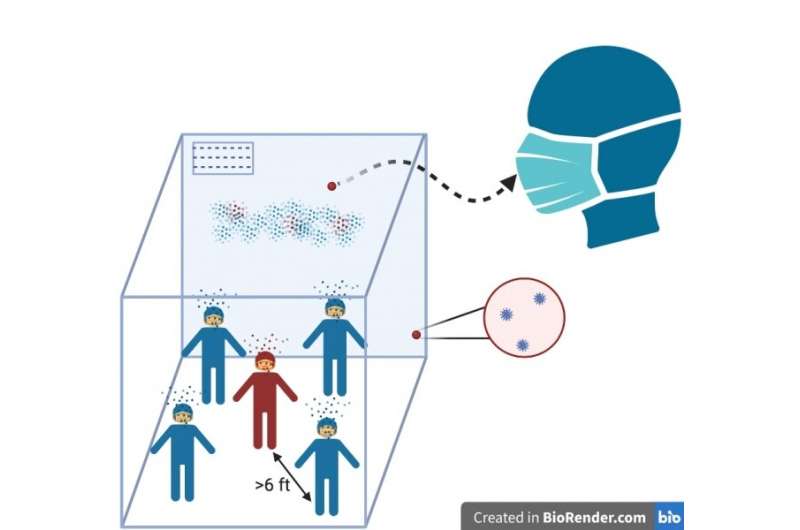Calculating the risk of COVID-19 exposure

Lucas Rocha Melogno and his fiancée had been planning their June 2020 wedding for two years. One hundred thirty guests would be attending from all over the U.S., as well as from Honduras, Ecuador, and Melogno's home country of Bolivia.
But Melogno, a Ph.D. candidate in the lab of civil and environmental engineering professor Marc Deshusses, has spent much of the past four years learning how exposures to aerosolized pathogens near open sewers influence the risk for contracting disease, and the thought of gathering 130 of his nearest and dearest into an indoor reception area during a pandemic wasn't sitting well with him.
The Deshusses Lab focuses on developing engineering solutions to global health challenges such as poor sanitation. In working to implement these solutions, Melogno has witnessed first-hand the necessity of tools that empower stakeholders to consider interventions in a risk assessment framework. He has focused on using his coding skills to translate complicated models of risk assessment into apps that are easy for people outside of academia to use. In fact, he had already launched one such app that assessed risk from exposure to aerosolized particles around open sewers, in collaboration with colleagues at the University of Notre Dame. When he came across a model from the University of Colorado Boulder's Jose Jimenez representing the factors that influence the risk of contracting COVID-19, Melogno saw an opportunity to turn the spreadsheet into another tool that could help users visualize and understand the risks associated with indoor gatherings.
"Aerosols linger in the air. They come out of the mouth and nose when people breathe, speak, or sing—all the things that would happen at a wedding," said Melogno. Anything smaller than a hundred microns can be inhaled and deposit in your nose, throat or lungs, he explained. The risk of inhaling these virus-laden aerosols indoors depends mainly on four factors: how close you are to the infected person, the length of exposure, the size of the occupied area, and the rate of ventilation in the area.
As he built the app in collaboration with Deshusses, Duke School of Medicine's Gregory Gray, and Notre Dame's Katherine Crank and Kyle Bibby, Melogno used his own wedding as a test case. He thought his guests would probably stay anywhere from one to four hours in the 500 cubic-meter space that he had reserved for the big event. He guessed the ventilation system would change out the air in the room 1-3 times per hour, which is typical for a room that size. And knowing the approximate ages of his guests and the activities they might be doing—laughing, dancing—made it possible to set advanced parameters within the app and estimate how quickly the guests would be breathing.
Additional calculations performed behind the user interface account for a fraction of the aerosolized particles settling where they can no longer be inhaled, and another fraction losing viability. The resulting dose—the amount of virus required to cause an infection—is theoretical as of now, because no animal studies have yet confirmed the numbers. And, the app assumes the people in the simulation are all wearing masks and practicing physical distancing and good hygiene, stressed Melogno.
So, what did the app calculate the risk to Melogno's guests to be? Zero point zero-zero-nine, meaning that if there was one infected guest at the reception of 130 people, it was likely that one other guest would receive a high enough dose of the SARS-CoV-2 virus to become infected, based on the parameters he had set.
To some, that risk may sound low. But who were the couple willing to put in harm's way? One of his groomsmen? The father of the bride?
"The level of risk was higher than we were willing to tolerate," Melogno said.
The couple postponed their wedding until October. Instead of a large gathering, they plan to host 20 people at a backyard reception, after a streamed Mass.
Melogno recently launched the app and shared a link on Twitter, which was quickly reshared several hundred times. The app has logged more than one hundred active users at the time of this story's publication. Though Melogno is not sure exactly who the users are, he thinks the app could be particularly helpful to engineers, space planners and public health professionals who are working to better understand health risks and communicate information to the public.
"I think the app has a lot of potential, as it can easily be adapted to many different kinds of exposures or contexts," said Deshusses. "For example, it may be helpful in making informed decisions about re-opening establishments like bars, movie theaters and gyms."
"Being at the end of my Ph.D., it's encouraging, because I realize my work matters," added Melogno.





















